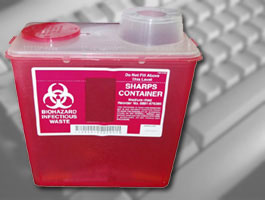
|
Bloodborne Pathogens |
|
Additional topics on infection control, aseptic techniques, and prevention of disease transmission are also included in this Bloodborne Pathogens Training Course for Healthcare Professionals. While these topics are not required as part of the OSHA Bloodborne Pathogens Standard, they are required by some states, and we highly recommend these topics even if it's not required in your location. This course can be used as introductory training as well as satisfy OSHA's annual refresher requirement.
Fee: $ 49.00
|
|
Online Training Course: Bloodborne Pathogens |
|
Who Should Take This CoursePersons who are exposed to blood and other potentially infectious materials (OPIM) while performing their routine work functions need to receive bloodborne pathogens training. This includes:
ObjectivesAfter completing this course, participants should be able to:
|
TopicsTopics include:
InstructorLorri L. White Ms. White is one of the principals of Eduwhere and has over 22 years of experience in the environmental industry. This includes 10 years working for an environmental laboratory that performed analyses environmental matrices such as soil, water and air as well as tissue and blood samples. In addition to her hand's on experience, Ms. White has taken numerous training courses on bloodborne pathogens and related topics to stay current with developments in the field, and she is an OSHA approved instructor. Ms. White received a BS in Chemistry from Saint Mary's College, Notre Dame, IN and completed a year of graduate level studies in analytical chemistry at the University of North Carolina at Chapel Hill. Contact Hours0.67 Industrial Hygiene CM Point (ABIH, Approval #10-072) 4 Contact Hours This represents the estimated time to complete the online course, including exercises. Actual times may vary from user to user. |
 Training RequirementCitation: 1910.1030(g)(2)(i) 1910.1030(g)(2)(i) Employers shall ensure that all employees with occupational exposure participate in a training program which must be provided at no cost to the employee and during working hours. 1910.1030(g)(2)(ii) Training shall be provided as follows: 1910.1030(g)(2)(ii)(A) At the time of initial assignment to tasks where occupational exposure may take place; 1910.1030(g)(2)(ii)(B) Within 90 days after the effective date of the standard; and 1910.1030(g)(2)(ii)(C) At least annually thereafter. Excerpt from 1910.1030 via OSHA website. How Often Does the BBP Certification for Healthcare Professionals Need to Be Updated?OSHA mandates that bloodborne pathogens training be renewed every year. Refresher Training Required: Every 1 year(s). | |
| Return to Course Description | |
Eduwhere · P.O. Box 4704 · Chapel Hill, NC · 27515
866-523-9108 (Toll Free) · 919.246.4847 (Voice) · 919.928.5173 (Fax) · Email: info@eduwhere.com
Copyright © 2001-2006 Eduwhere & Keika Ventures, LLC. All rights reserved.
Eduwhere is the training division of KeikaVentures, and KeikaVentures is a woman owned business.